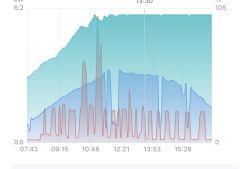I understand that this is the length of the heater. But should I understand that the design of the radiator and heater makes it impossible to even partially insert it into the tank "at an angle"?

Czy wolisz polską wersję strony elektroda?
Nie, dziękuję Przekieruj mnie tampodleckipawel wrote:Hello, while looking for information on the possibility of installing a heater, I came across this topic and today I managed to install the heater in place of the drain valve.
900W heater, 1/2 thread, WZ tee with sealing ring. The heater comes on without any problems, mine has 3 temperature setting modes: 20, 40, 60 ° C and Turbo modes.
If I can help you with anything, greetings.
podleckipawel wrote:.Unfortunately for such capacities these heaters are not sufficient, they are generally for bathroom or panel radiators.
If they are switched on non-stop, they will probably wear out quickly and the water will only be warm in the lower part if it is not used, the cold water supply is from the bottom of the tank and it is unlikely to be possible to heat it completely.
At least 2.5kW would be useful.
shysheq wrote:.Today from 30.4st C to 42.4st C the water took 98 minutes to heat.
 .
.
